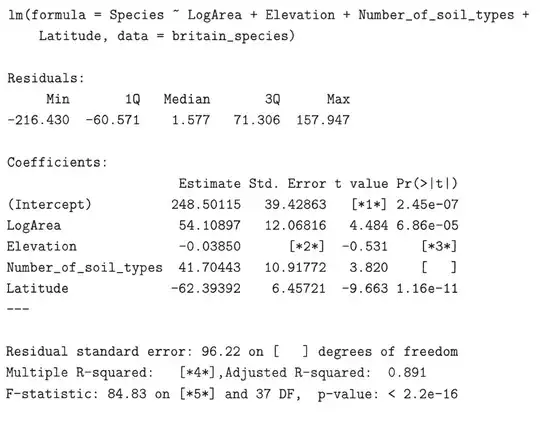This looks like a homework problem, so I'll be a bit coy with my answer.
If you're allowed to use adjusted $R^2$, you can do it.
$$R^2_{adj} = 1 - (1-R^2)\dfrac{n-1}{n-p}$$
Here, $p$ is the number of parameters estimated in the $\beta$ vector including the intercept.
The printout gives you $R^2_{adj}$. The printout also gives you the number of parameters you've estimated ($p$) and the number of observations ($n$) used to fit the equation. Then it's just algebra.
Do you see how you get $p$ and $n$ from the printout? (That's what makes this a statistics question for Cross Validated instead of a programming question that should be on Stack Overflow.)
EDIT
After discussing in the comments and chat enough that I can see that you get how to do the problem, I will give a full solution.
The first $df$ in the F-stat is $p-1$, where $p$ is the number of parameters including the intercept. There are five parameters, do $df_1=4$. Then it is given that $df_2=37$.
$df_2 = n-p$, so $n=df_2+p = 37+5=42$.
Now we go to the $R^2_{adj}$ equation and plug in these values.
$$
R^2_{adj} = 1 - (1-R^2)\dfrac{n-1}{n-p}
$$
$$
0.891 = 1 - (1-R^2)\dfrac{41}{37}
$$
The algebra shows that $R^2 = 0.9016341463414634$.
A comment by whuber mentioned that you can relate the F-stat to $R^2$, too. From this question, we see that the relationship is $F = \dfrac{ R^2 }{ 1- R^2} \times \dfrac{ df_2 }{ df_1 }$. Let's plug in the numbers.
$$
84.83 = \dfrac{ R^2 }{ 1- R^2} \times \dfrac{ 37 }{ 4}
$$
The algebra shows that $R^2 = 0.9016794217687075$. This is almost the same as the value from the other method, and if you consider only the three significant figures in the given $R^2_{adj}$ value, they are the same: $0.902$. The F-stat and $R^2_{adj}$ value are rounded in the printout, so I think it is fair to round to three decimal places and say that $R^2 = 0.902$.
